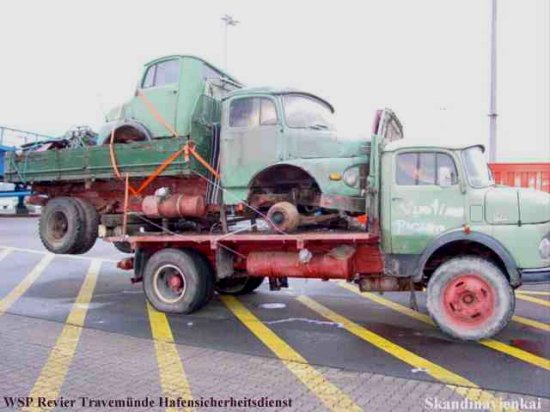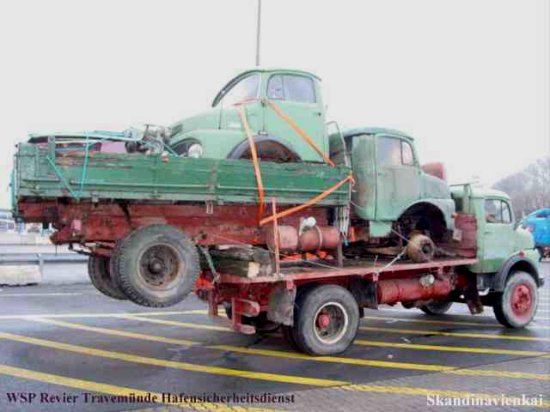| Photo of the month – December 2003 – Special 1 | [German version] |

Figure 1
Don’t worry, it’ll be okay!
What you see here are trucks on their way from Finland via Travemünde and Hamburg to their final destination in Africa. Not that they got any further than Travemünde to start with!
What is the first thing a load securing expert might notice?
- How about load distribution? Yes! Spot on. There is definitely need for improvement in this area.
- Friction coefficients? Another good point – the friction coefficients leave more than a little to be desired. Why? Because steel has been loaded on steel, and as is often the case with older vehicles, oil is likely to leak and contribute to a further reduction of the friction coeffficient. On the loading area at the rear friction has been improved by adding wooden underlays. True. But this was probably done to improve stability not to secure the load.
- Load securing measures? Well spotted! Why? A lot of material has been used and the tie-downs which are usually frowned on are barely in evidence. Correct again! Direct lashing is a good thing, and it must be said, the tight-fit at the front is also fine. But closer inspection does reveal a couple of other flaws! Such as? Well, for starters, tie wire is not exactly first choice material for transportation by road. Why? Because of the dynamic forces. The wire becomes "slack", and the critical "emergency braking force" must then be taken up by a loose load securing material! But no load securing material is able to do this, and tie wire most certainly can’t!
But while we’re on the subject of dynamic loads, the truck has just come off a ship hasn’t it. Ships are where you most expect dynamic loads aren’t they? Correct again! We are at a loss. And we can’t explain why the cargo loading officer accepted this scrapyard on wheels in the first place.
- Dimensioning of the load securing measures? A key issue! The rather idiosyncratic loading methods used here cannot be rectified with load securing measures. One thing is for sure: anyone who wishes to apply the German VDI guidelines here is going to have their work cut out.
What is the proper way to transport something like this? Good question!
In a closed container? Yes, for example! But a low loader and the appropriate DIRECT LASHINGS would also be suitable! And with a construction of this nature, you need to make sure that no loose parts are free to wreak havoc in or on the vehicle or the loading area.
Many thanks go to the habor police. As is often the case, they have prevented a disaster waiting to happen. Safety for all in our ports!!!

Figure 2
Back to beginning
